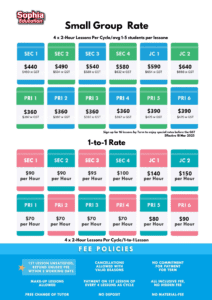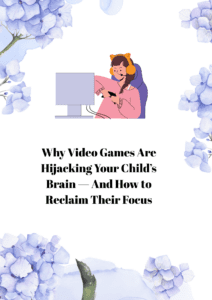Why Video Games Are Hijacking Your Child’s Brain — And How to Reclaim Their Focus
Discover how video games affect your child’s brain development and attention span in 2025. Learn expert-backed strategies to help reclaim their focus, build better habits, and restore balance with this in-depth parenting guide.
Table of Contents
-
Introduction
-
The Rise of Video Games in 2025
-
The Science Behind the Screen: What Video Games Do to the Brain
-
Recognizing the Signs of Gaming Addiction
-
Why Kids Get Hooked: Psychological Triggers of Video Games
-
The Impact on Focus, Memory, and Academic Performance
-
How Video Games Affect Sleep, Mood, and Social Skills
-
How Much Is Too Much? Setting Healthy Boundaries
-
Step-by-Step: Reclaiming Your Child’s Focus
-
Tools and Techniques for Parents in 2025
-
Building Better Habits: What to Replace Screen Time With
-
Real-Life Success Stories from Singaporean Families
-
Final Thoughts: Empathy, Balance & Long-Term Growth
-
Resources & Further Reading
1. 🧠 Introduction: The New Parenting Battlefield
It’s 2025, and video games aren’t just a pastime — they’re an all-consuming digital universe. As a parent, you may have found yourself losing the daily battle for your child’s attention. From Fortnite to Roblox to mobile gacha games, digital entertainment is designed to hijack attention and manipulate the brain.
But it’s not all doom and gloom. This guide is your playbook for understanding the science behind video game addiction and learning how to reclaim your child’s focus without punishment or power struggles.
2. 🎮 The Rise of Video Games in 2025
🚀 Quick Stats:
-
92% of Singaporean children aged 7-18 play video games.
-
The average gaming time per week: 18 hours.
-
1 in 4 children shows signs of gaming addiction.
The video game industry is now worth over $300 billion globally. Games are no longer just for fun—they are social platforms, status symbols, and sometimes even full-time careers. Your child isn’t just playing; they’re immersing, escaping, and investing emotionally.
3. 🧬 The Science Behind the Screen: What Video Games Do to the Brain
When your child plays a video game, several things happen in their brain:
🧠 Neurochemical Reactions:
-
Dopamine spikes: The brain releases dopamine (pleasure chemical) during wins or rewards.
-
Neuroplasticity changes: The brain rewires itself to respond faster to gaming stimuli.
-
Delayed gratification weakens: Constant rewards from games reduce patience and long-term focus.
MRI studies have shown that the prefrontal cortex, the area responsible for impulse control and decision-making, becomes less active the more time children spend gaming.
4. 🚨 Recognizing the Signs of Gaming Addiction
Knowing when it’s just a hobby vs. a harmful habit is key. Look out for:
⚠️ Red Flags:
-
Loss of interest in school, family, or hobbies.
-
Aggression or irritability when asked to stop playing.
-
Lying about screen time.
-
Skipping meals, sleep, or responsibilities.
-
Social withdrawal and mood swings.
If you notice 3 or more signs consistently, it’s time to intervene constructively.
5. 🧠 Why Kids Get Hooked: The Psychological Triggers of Games
Game developers use behavioral psychology to make games irresistible:
🎯 Triggers Used:
-
Variable rewards (like gambling): Players never know when the next big win will come.
-
Social pressure: Friends online expect you to be available.
-
Daily rewards/streaks: Miss a day, and you lose progress.
-
Level-up systems: Instant feedback and visible success.
These features are designed to exploit the brain’s reward center and form habit loops quickly.
6. 📉 The Impact on Focus, Memory, and Academic Performance
Gaming doesn’t just eat time — it rewires your child’s brain:
-
Reduces attention span: Switching from games to classroom tasks becomes harder.
-
Affects working memory: Children struggle to hold information temporarily.
-
Impacts academic confidence: School becomes “boring” compared to games.
-
Multitasking illusion: Kids believe they can multitask (watch YouTube, play games, study) — research shows this significantly reduces retention.
At Sophia Education, we’ve seen students dramatically improve their grades after reducing their screen time — with personalized tuition giving them an engaging offline alternative.
7. 🌙 Sleep, Mood, and Social Skills: The Hidden Damage
😴 Sleep Disruption:
-
Blue light from screens affects melatonin.
-
Gaming before bed delays sleep onset.
-
Children feel tired, cranky, and less productive.
😤 Mood Swings:
-
Increased aggression from competitive or violent games.
-
Anxiety from online social drama.
-
Depression linked to isolation or online bullying.
🗣️ Social Disconnect:
-
Preferring virtual interaction over face-to-face.
-
Avoiding family time or real-world friendships.
-
Loss of emotional regulation during conflict.
8. ⏰ How Much Is Too Much? Setting Healthy Boundaries
The World Health Organization suggests:
-
Ages 5-12: Max 1 hour/day
-
Ages 13-18: Max 2 hours/day
But every child is different. What matters most is:
✅ Screen time quality over quantity.
✅ Having off-screen hobbies and responsibilities.
✅ Consistent daily routines.
Use apps like Google Family Link, Forest, or Freedom to monitor and limit screen time.
9. 🛠️ Step-by-Step: Reclaiming Your Child’s Focus
👣 Phase 1: Awareness
-
Have a calm, open conversation about their screen habits.
-
Ask questions like: “What do you enjoy most about the game?”
-
Avoid blame. Focus on how it’s affecting their goals.
👣 Phase 2: Audit
-
Track their screen time for 7 days.
-
List what tasks or interests were replaced (e.g., studying, sports, family time).
👣 Phase 3: Replace, Don’t Remove
-
Don’t just ban games. Introduce rewarding alternatives.
-
Schedule 1-on-1 time: biking, art, sports, even puzzle games together.
-
Enroll in engaging classes like coding, music, or tuition classes that spark curiosity.
👣 Phase 4: Set Limits Together
-
Use a tech agreement (e.g., 2 hours gaming only after homework).
-
Let them suggest alternatives. The goal is shared responsibility.
10. 🧩 Tools and Techniques for Parents in 2025
✅ Digital Wellbeing Apps
-
Google Family Link
-
Apple Screen Time
-
Bark (alerts for harmful content)
✅ Timers & Incentives
-
Use visual timers like Time Timer.
-
Introduce point systems or reward charts.
✅ Create Screen-Free Zones
-
No phones in bedrooms or during meals.
-
Create a “Focus Hour” in the evening.
✅ Mindfulness Practices
-
Teach your child breathing techniques.
-
Use apps like Headspace or Calm (family plans).
11. 🌱 Building Better Habits: What to Replace Screen Time With
Here’s a list of engaging alternatives to screens:
🎨 Creative
-
Drawing, painting, journaling
-
DIY crafts or Lego
⚽ Physical
-
Join a sports team
-
Martial arts, dance, or yoga
📚 Academic
-
Join a book club
-
Personalized tuition classes like IP tuition or PSLE tuition
-
Science kits or educational board games
👨👩👧 Family
-
Weekly game night (offline!)
-
Cooking or baking together
🎵 Enrichment
-
Learn a musical instrument
-
Attend holiday workshops or camps
✨ These build your child’s identity beyond the screen — and foster focus, patience, and confidence.

12. 💬 Real-Life Success Stories from Singaporean Families
👨👩👧Case Study 1: PSLE Student Turnaround
Jasmine (P6) was gaming 5+ hours a day, failing Science and English. Her parents enrolled her in PSLE tuition at Sophia Education. With structured learning and reduced gaming, she jumped from C to A within 4 months — and found joy in reading again!
👨👩👦👦 Case Study 2: JC1 Boy’s Comeback
Samuel (JC1) struggled with time management and skipped classes due to online gaming. After integrating JC tuition and limiting gaming to weekends, his GP scores and mental health both improved — and he started working on his own comic book!
13. 🧘♀️ Final Thoughts: Empathy, Balance & Long-Term Growth
Reclaiming your child’s focus isn’t about control — it’s about coaching them through a world that’s more addictive than ever.
✅ Be patient.
✅ Be consistent.
✅ Focus on long-term habits, not quick fixes.
Games aren’t evil — but without structure and guidance, they can consume your child’s time, attention, and potential. With empathy, education, and firm routines, you can help your child build a balanced, fulfilling life — online and offline.
14. 📚 Resources & Further Reading
-
“Dopamine Nation” by Dr. Anna Lembke
-
WHO Guidelines on Screen Time
-
Apps: Forest, Headspace, Bark, Family Link
-
Singapore Parenting Forum (2025 Edition)


🏁 Conclusion
The digital world will only grow more immersive — but so will our understanding of the brain and behavior. As a parent, your role as a gentle guide and protector of focus is more critical than ever. Use this guide as your blueprint for positive change.
🧡 You’ve got this — and your child needs you more than ever.



